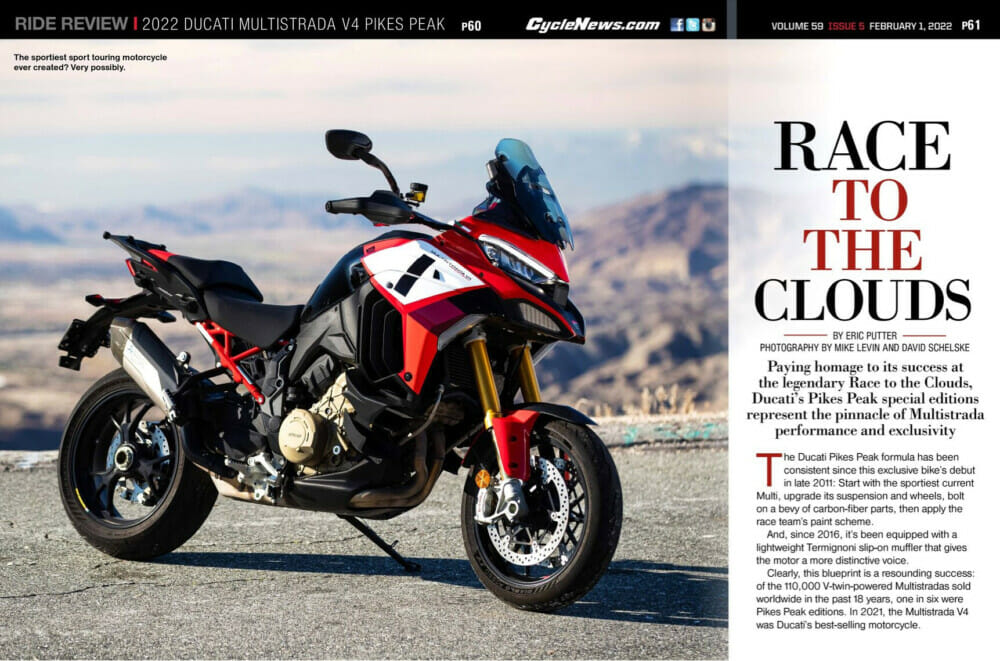| February 3, 2022
Paying homage to its success at the legendary Race to the Clouds, Ducati’s Pikes Peak special edition represent the pinnacle of Multistrada performance and exclusivity.
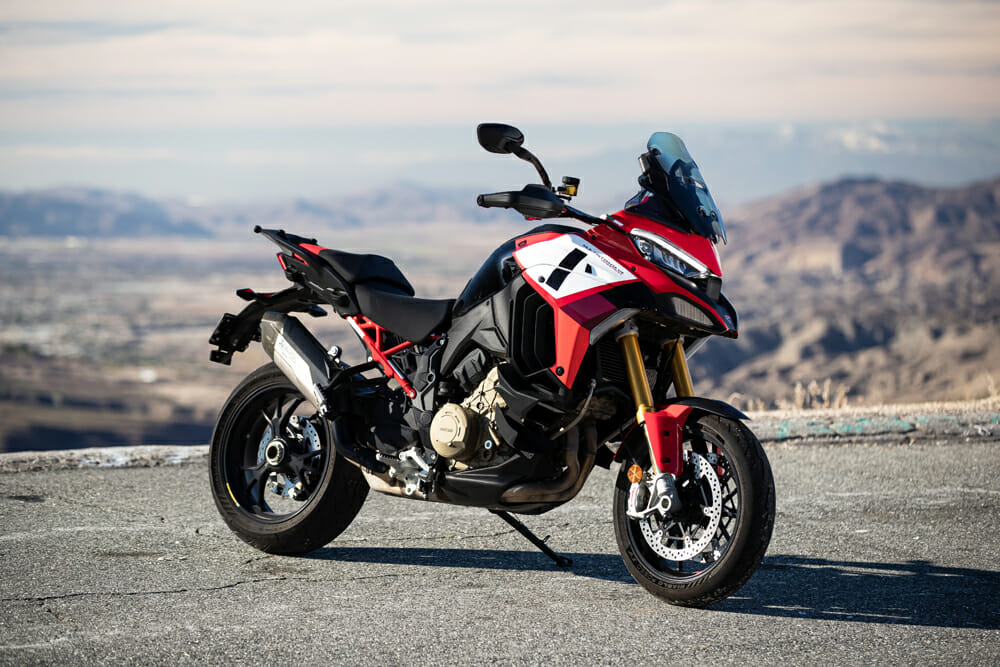 The sportiest sport-touring motorcycle ever created? Very possibly.
The sportiest sport-touring motorcycle ever created? Very possibly.
By Eric Putter | Photography By Mike Levin and David Schelske
The Ducati Pikes Peak formula has been consistent since this exclusive bike’s debut in late 2011: Start with the sportiest current Multi, upgrade its suspension and wheels, bolt on a bevy of carbon-fiber parts, then apply the race team’s paint scheme.
And, since 2016, it’s been equipped with a lightweight Termignoni slip-on muffler that gives the motor a more distinctive voice.
Clearly, this blueprint is a resounding success: of the 110,000 V-twin-powered Multistradas sold worldwide in the past 18 years, one in six were Pikes Peak editions. In 2021, the Multistrada V4 was Ducati’s best-selling motorcycle.
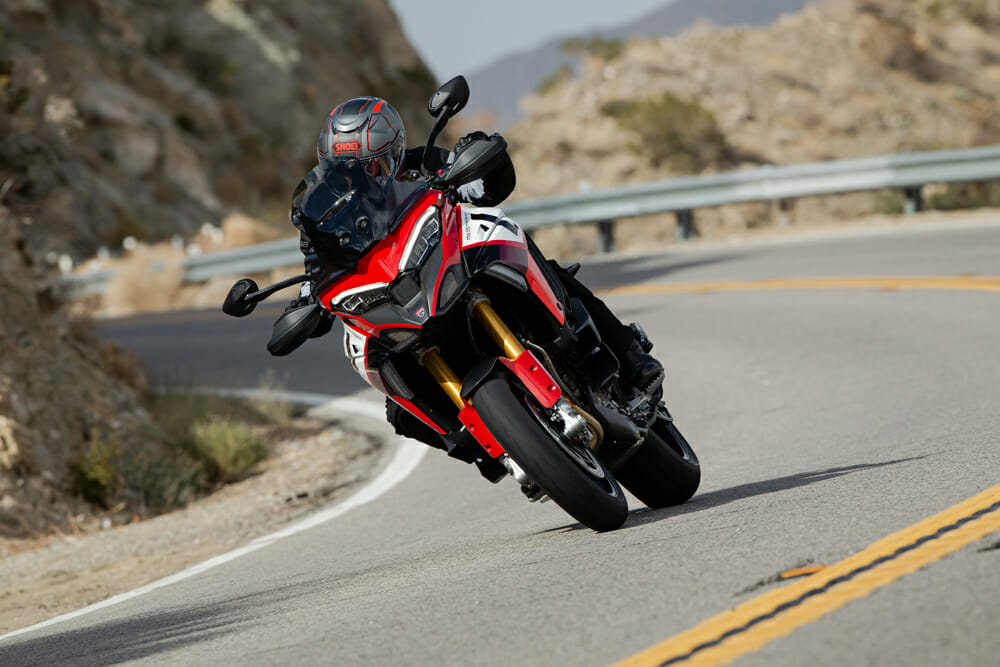 The V4 turns with the kind of speed and precision normally reserved for bikes with fairings and slicks.
The V4 turns with the kind of speed and precision normally reserved for bikes with fairings and slicks.
From 70-Percent Dirt to 90-Percent Street
Ducati went above and beyond the well-established formula on its first Pikes Peak of the V4 era. To restore street cred, this special ‘Strada’s sport bike mojo was reignited by reversing design decisions that gave last year’s model a dose of dirt worthiness and adopting high-end hard parts straight from the Panigale and Streetfighter V4 S models.
To carve sharper lines, the Multi’s monocoque front frame was revised with a 1.25-degree steeper rake angle. Offsetting the loss of stability that comes with reducing rake is a longer, single-sided swingarm in place of the conventional, dual-sided piece. These changes netted a 1.1-inch longer wheelbase than the standard Multistrada.
Taking advantage of this revised chassis, the Multi’s standard 19-inch front wheel was ditched in favor of a proper 17-incher. Forged, three-spoke Marchesini wheels grace both ends, and these Panigale V4 S-spec rims lower the bike’s unsprung weight by 5.95 pounds.
In the real world, this allows Öhlins’ cutting-edge Smart EC 2.0 electronic suspension to work more effectively.
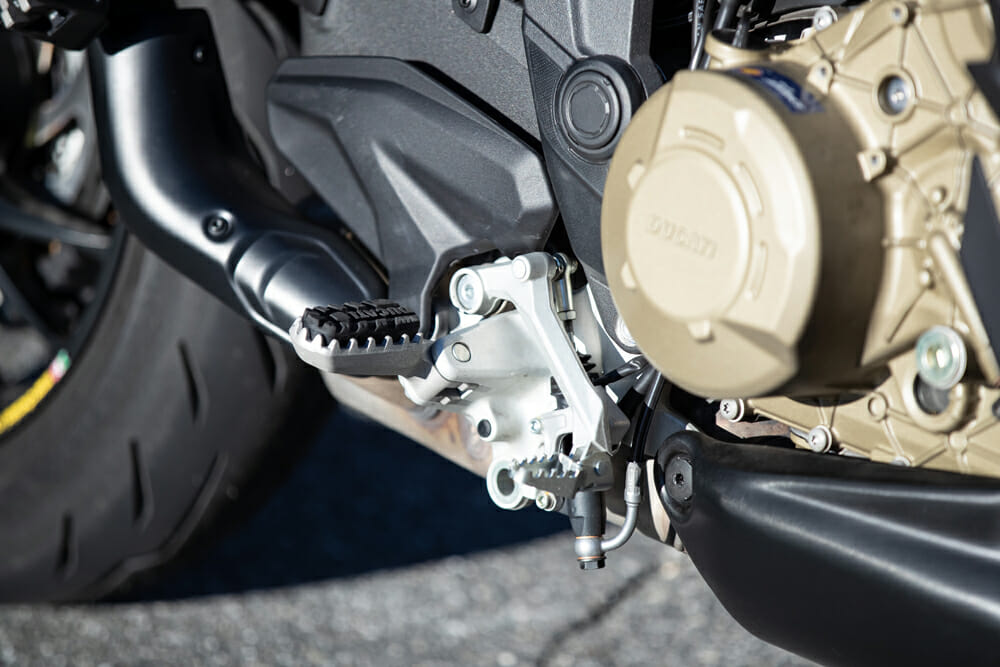 Skinny little footpegs send a few vibes through the rider’s feet.
Skinny little footpegs send a few vibes through the rider’s feet.
The wheels also reduce the gyroscopic effect, as does the motor’s counter-rotating crank. Their built-in attributes result in light steering effort, especially in quick transitions.
A narrower handlebar provides lots of leverage. With less rise and pullback, it also helps riders put more weight on the front end, increasing grip and feel. Footpegs raised by 10mm and pushed back by 10mm make the bike feel sportier.
All of these changes allow the long, tall machine to hustle around mountains with more competence and composure than most 500-plus-pound (actually, 527 claimed with the fuel tank filled to 90 percent) motorcycles.
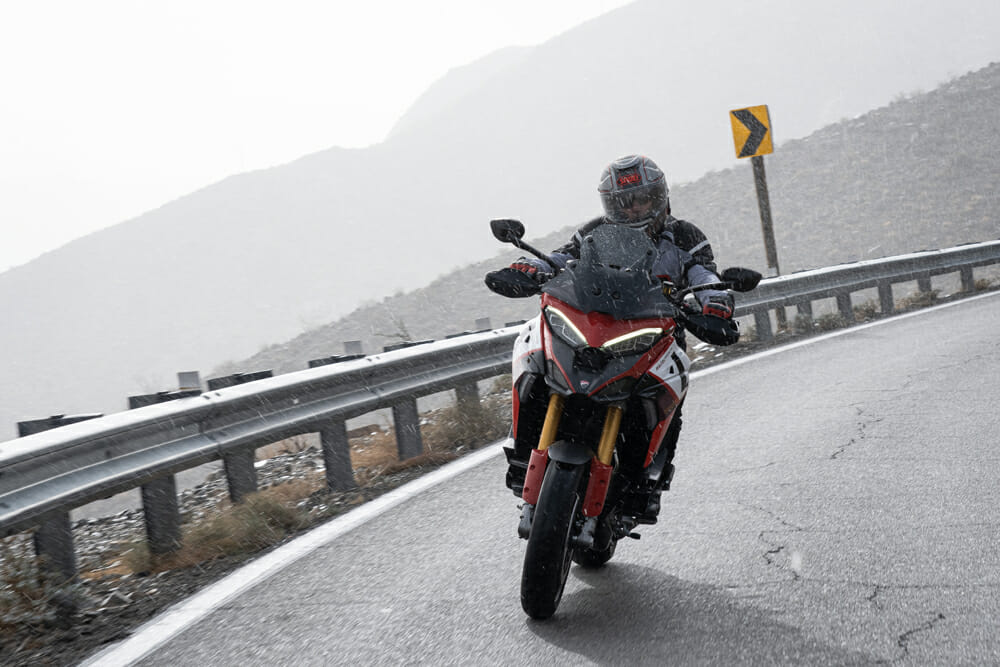 Proof we test in all weather! At this point it was barely over 30° F.
Proof we test in all weather! At this point it was barely over 30° F.
The Cost of Progress
Sporting about $15,000 in high-end hard parts, priceless chassis changes and major software reprogramming, this $28,995 V4 Pikes Peak costs $2900 more than the cast-wheel-shod Multistrada V4 S. Outfitted for sport touring, the 2022 V4 S comes with $2000 worth of accessories: Color-matched saddlebags, heated grips, heated seat and center stand. The last Pikes Peak V-twin retailed for $25,795—a $4500 premium over the 1260 S on which it’s cast.
Prelaunch Meet and Greet
Due to the 156-turn, 12.42-mile race course’s starting line hovering at 9400 feet and checkered flag flown at more than 14,000, winter road conditions kept the 2022 Multistrada V4 Pikes Peak press introduction from taking place on the fabled mountain near Colorado Springs.
Weather on our ride to the clouds—from a five-star basecamp in Palm Springs (elevation: 479 feet), to mile-high Idyllwild—was as volatile as racers experience in June at Pikes Peak when the motorcycles raced there.
A gleaming row of identical bikes and their handlers were steps away from our posh hotel rooms, ready for the green flag to fly. Dressed in a MotoGP-derived livery accented with rich carbon-fiber side panels, front fender and ignition switch cover, each Pikes Peak has a distinctive two-tone passenger seat and an official-looking Ducati Corse badge on its short-cropped beak.
Dialing in the bike’s setup took seconds. Instead of drilling down into various menus to find Auto-Leveling (for suspension preload adjustment) and Ride Modes (which control most everything else), individual buttons atop the left-side switchgear provide direct access.
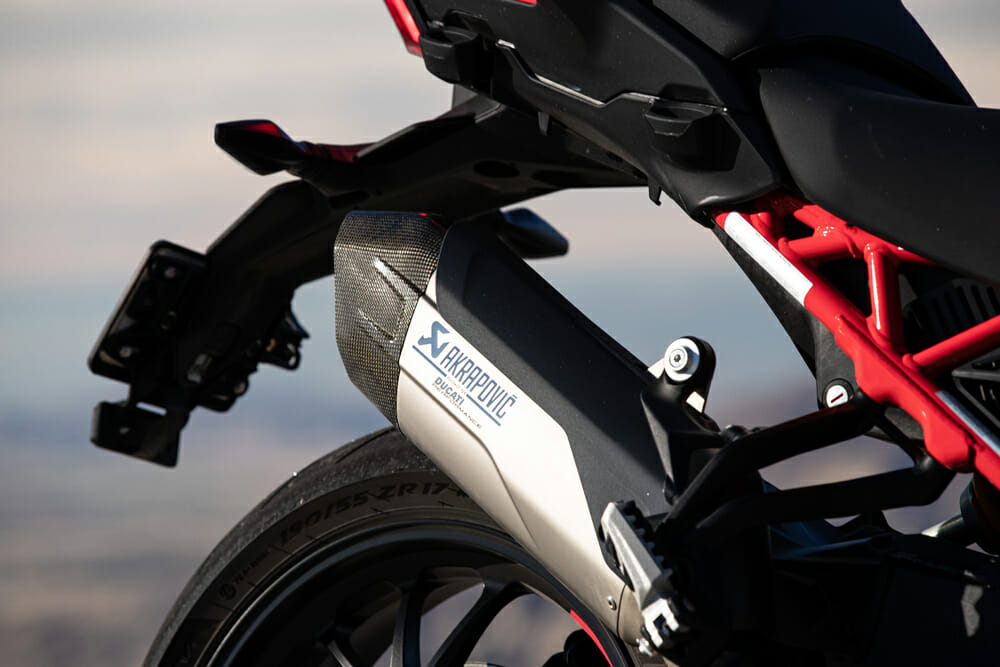 The Pikes Peak-standard Akrapovic exhaust adds a touch of class to an already classy package.
The Pikes Peak-standard Akrapovic exhaust adds a touch of class to an already classy package.
Ride To The Clouds
As a testament to Ducati’s latest engine-management, traction, braking and suspension-control technology, the group survived this tempest—riding through rain whipped by wind gusts up to 50 mph, minor mudslides and fast-moving streams of runoff—with reflexes slowed by temperatures in the 30s, through wet, numb extremities and a fogged-up face shields.
Mile after miserable mile, the high-end Multistrada proved why it’s so much more capable in such brutal conditions than the more explosive, sharper handling, less comfortable, totally minimalistic Panigale and Streetfighter V4s I’d ridden 5000 miles in the span of 18 months—even though these super-duper Ducks have near-identical electronic rider aids and “smart” suspension components as the mighty adventurer.
As a reward for surviving the press ride without crash-testing one of its stars, Ducati loaned me another Pikes Peak V4 soon after the intro. We managed to rack up another 300 miles together on drier roads in slightly warmer temps.
 Carbon fiber cloaks the little black box for the radar-assisted Adaptive Cruise Control.
Carbon fiber cloaks the little black box for the radar-assisted Adaptive Cruise Control.
Electronic Wonderland
Much of the Multistrada’s good manners can be attributed to a sophisticated suite of electronic rider aids.
This 2022 version is the first to have different ride modes than other current Multistradas. These modes—factory-determined groups of electronic settings—tailor engine character, traction control, wheelie modulation, ABS sensitivity, suspension preload and damping levels. They allow riders of differing skill levels and bike-setup preferences to quickly dial in the motorcycle to better suit road conditions, as well as compensate for passenger and luggage weight.
Along with replacing the standard model’s dirt-focused 19-inch front wheel and dual-sided swingarm, the Multistrada V4’s Enduro riding mode was eliminated (but strangely, not its folding shifter and brake pedals). Now, the Pikes Peak has Urban, Touring, Sport and a first-ever Race mode that kicks the motor up a notch, lowers traction and wheelie control to just 25 percent of their max settings and stiffens preload by six clicks over the Sport setting.
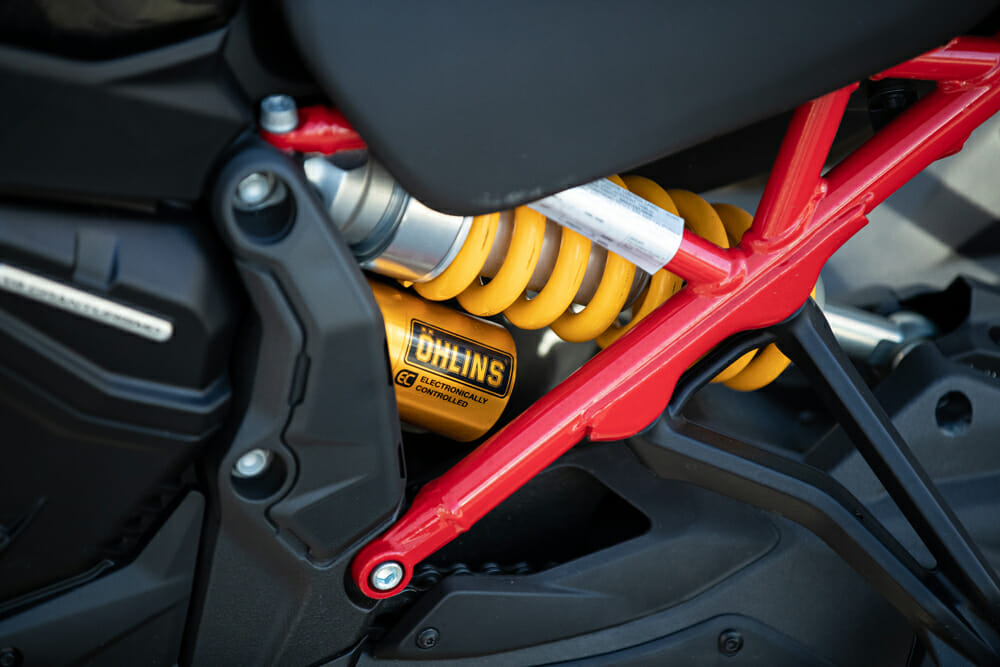 Electronic Öhlins allow you to dial in a near perfect auto-assisted ride. If you can’t find one, you can always switch it to manual and go old school with compression, rebound and preload adjustment.
Electronic Öhlins allow you to dial in a near perfect auto-assisted ride. If you can’t find one, you can always switch it to manual and go old school with compression, rebound and preload adjustment.
Any of the four presets can be saved as the preferred riding mode. And, unlike many earlier and less sophisticated current systems, each parameter can be customized individually (or turned off) and saved by users. Once chosen, these settings “stick,” instead of reverting to factory defaults when the bike is turned off.
Overall, the electronic rider-aid strategies have been reprogrammed to emphasize the sporty side of sport touring. The system gathers and processes information more intuitively, then reacts with quicker reflexes. Updated throttle mapping is said to give more direct response, especially in Race mode, which proved to be a bit too aggressive for fast street riding. Responding to customers who couldn’t figure out where the V4’s prodigious power peaks, the rev limiter was reprogrammed to more progressively extinguish the fire.
According to Ducati, traction control has been tuned for “more dynamic riding.” Better yet, wheelie control was tweaked to offer “more accuracy for impulsive maneuvers” and the ABS system allows a bit of rear-wheel lift upon threshold braking in two of its three settings.
The final bit of reprogramming is quickshifter tuning to provide faster, cleaner gear changes, even when used in an “extremely aggressive” manner.
The dirty little secret about this race-derived technology is that most of them work well at high rpm, but produce rough, awkward shifting in everyday street riding at sane engine speeds. I’d a prefer a transmission that offers smooth-as-butter clutchless upshifts over a balky quickshifter. Maybe next year’s Multi will get the latest Panigale’s EVO 2 quickshift software that is said to smooth things out.
While the electronics package is sophisticated, easy to adjust and otherwise works seamlessly, the V4 Panigale and Streetfighters have programmable Engine Braking Control that was sorely missed on this ultimate Multi. If three modes for engine braking were baked in, the Granturismo feels as though it’s stuck the most intrusive setting.
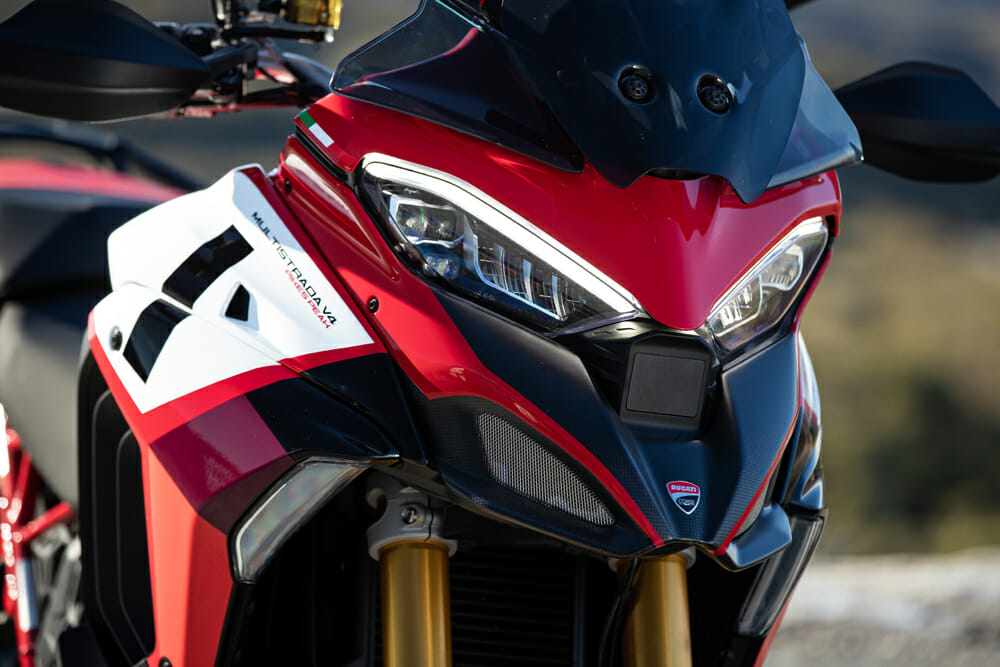 This famous face won the Pikes Peak International Hill Climb with the late Carlin Dunne three times.
This famous face won the Pikes Peak International Hill Climb with the late Carlin Dunne three times.
From Stradale to Granturismo
Ducati introduced the Multistrada’s 1158cc Granturismo motor with great fanfare last year and for good reason. Based on the Panigale’s 1103cc Stradale engine, it’s clearly the best street use so far of the V4 platform. Kawasaki’s supercharged H2 motor responded similarly when reconfigured for sport-touring use.
That said, the new motor was civilized for all-around duty with smaller throttle bodies, lower redline and other detuning tricks. The Granturismo’s superpower is making more useful power, without losing the big-bang V4’s sound or character. Although it pumps out 40 less peak horsepower than the Panigale’s Stradale, those ponies are accessible 2000 rpm sooner. The Multi motor produces five more pounds of torque than the superbike, but 2500 rpm earlier. This powerband is complemented by wider transmission ratios and taller overall gearing that feels perfect for its intended mission.
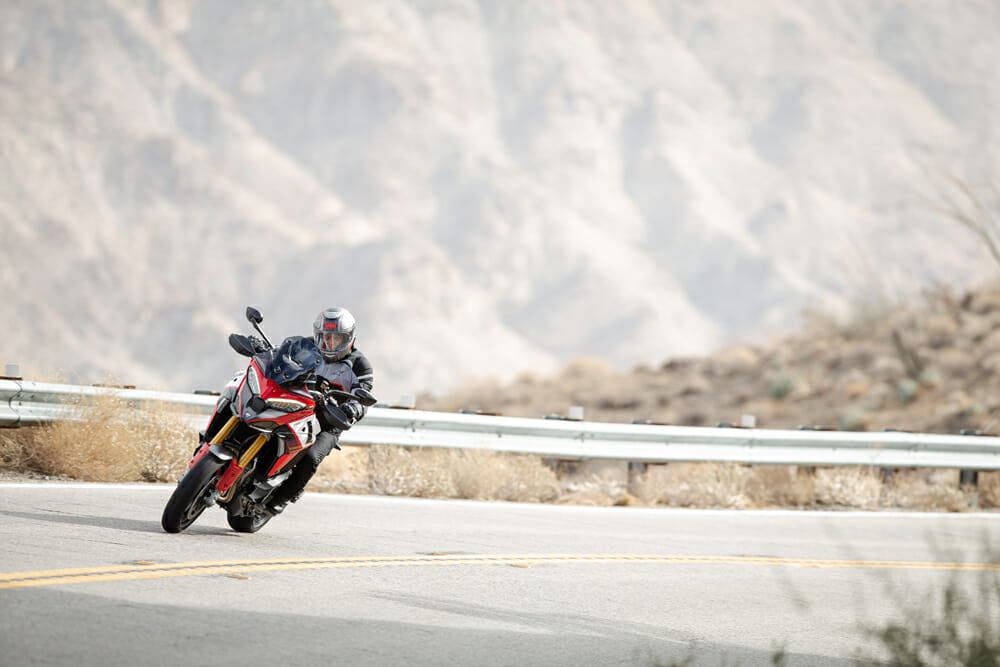 Find your nearest canyon and you’ll never want to get off the Multistrada V4 Pikes Peak.
Find your nearest canyon and you’ll never want to get off the Multistrada V4 Pikes Peak.
Quietly Bucking Tradition
Ducati is defined by deeply rooted mechanical signatures. Much to its credit, this ultra-competitive company has incrementally embraced advances in materials and technical innovations. Rattling, heavily sprung dry clutches gave way to quiet, oil-bathed, low-effort clutch packs. Cam chains superseded toothed belts. Sophisticated V4s supplanted booming, V-twin superbikes.
And now, very quietly, the Desmodronic valvetrain employed by every Ducati motor for the past 65 years has been replaced by a conventional system that keeps the Granturismo’s intake and exhaust valves closed with springs.
This dramatic break from tradition enables the 1158cc engine to go 37,282 miles between valve adjustments, which is more than most modern bike motors, and, better yet, may qualify for a Guinness World Record. More importantly, this is twice the recommended valve-service intervals of the 1103cc Stradale V4 and the Multistrada’s old 1260cc V-twin.
Ducati seamlessly transplanted the DNA, technology, user interfaces, feel, sound and unique vibe of two absolutely bonkers road bikes—the Panigale and Streetfighter—in this third-generation, V4-powered Multistrada Pikes Peak, another quintessential Ducati in its most modern form.
A Week With The Beast
Rennie Scaysbrook
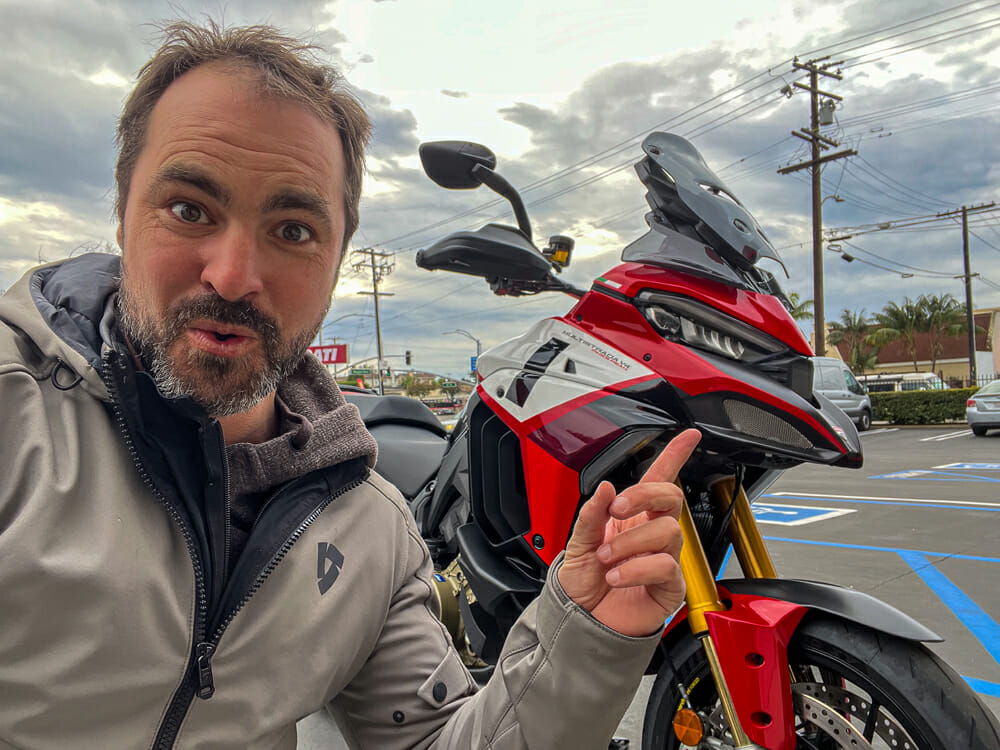
I missed the V4 Pikes Peak launch due to a few administrative issues that required my immediate attention, but that wasn’t going to stop me getting at least a few miles on one.
One quick jaunt up the back roads separating Orange County from the Inland Empire, a trip to Anaheim for Supercross and two lunch runs had me pretty close to convinced I may have found my ideal motorcycle.
The older I get, the more I enjoy a large motorcycle. Not necessarily large capacity/horsepower, but spacious and roomy, which is something the V4 has in spades. It’s comfortable almost to a fault, and I find the rejigged ergonomics more pleasant than the base model Multi, which is designed to go both on and off road.
With 17-inch wheels and no concessions to off-road performance, the V4 Pikes Peak is the grandest of grand sports tourers. It’ll get up and boogie with the best of them (170 horsepower will do that) but the way in which it delivers said power, and the slightly lazier geometry makes for exceptional stability and poise.
Although it’s stable, it’s also far sportier than you may think at first glance. For a bike weighing north of 500 pounds fully fueled, it’s dynamically nimble in the twisties and once you get out of the city you’ll hardly want for anything else.
The riding modes are all well and good, but I like the snappiness of the Race mode and thus left it in there for the duration of my week’s ride. Of course, there’s the Adaptive Cruise Control and Blind Spot Detection software built in, and this is something every rider simply must try. It’s an absolute game changer for highway use and puts this bike on a higher pedestal than most.
The Multistrada V4 S was my pick for Bike of The Year in 2021, but it’s a good thing I hadn’t ridden the V4 Pikes Peak edition before I made my selection. As good at the V4 S is, it’s a big bike and I’d sooner go for a mid-size ADV machine if serious off-road usage is on the cards. But the V4 Pikes Peak is so damn good at being a damn good street bike, that it’s already going to be hard to top for 2022.CN
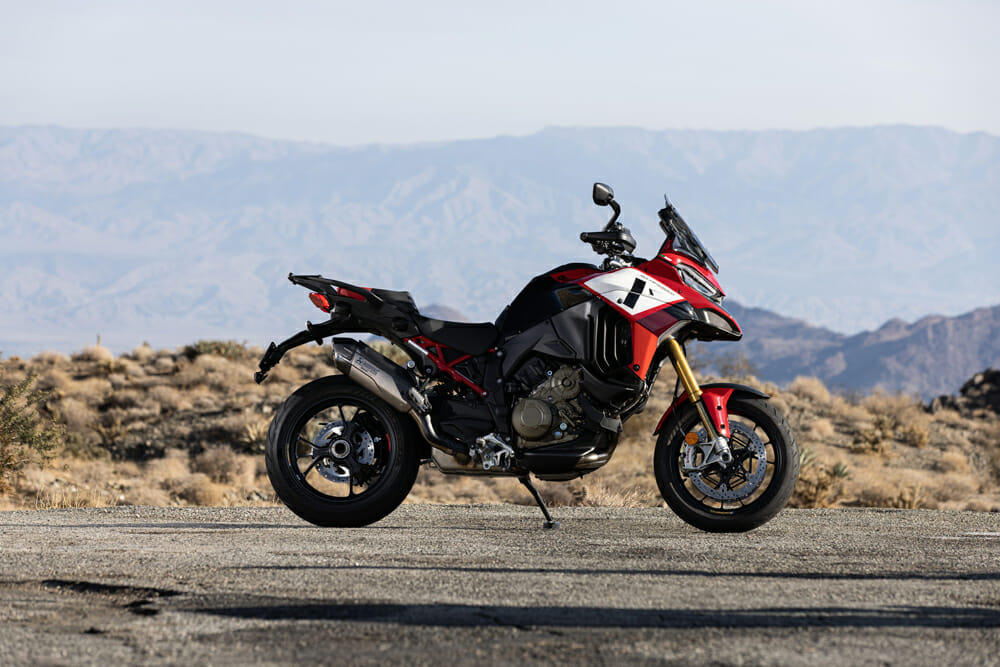
2022 Ducati Multistrada V4 Pikes Peak Specifications
| MSRP: |
$28,995 |
| Engine: |
Granturismo 90° V4, counter-rotating crank, Twin Pulse firing order |
| Valvetrain: |
DOHC, 4 valves per cylinder |
| Cooling system: |
Liquid |
| Displacement: |
1158cc |
| Bore x stroke: |
83 x 53.5mm |
| Compression ratio: |
14.0:1 |
| Fueling: |
Electronic, twin injectors per cylinder, full ride-by-wire 46mm elliptical throttle bodies, fixed-length intake system |
| Horsepower (claimed): |
170 hp at 10,500 rpm |
| Torque (claimed): |
92 lb-ft at 8750 rpm |
| Exhaust: |
4-2-1 |
| Transmission: |
6-speed with Ducati Quick Shift (DQS) up/down |
| Clutch: |
Hydraulically controlled slipper and self-servo wet multi-plate clutch |
| Electronics: |
4 Riding Modes, Power Modes, Cornering ABS, Ducati Traction Control, Ducati Wheelie Control, Ducati Quick Shift (up & down), Vehicle Hold Control, Adaptive Cruise Control, Blind Spot Detection, full LED lighting, Daytime Running Light, Ducati Cornering Light, Ducati Brake Light, backlit handlebar switches, 6.5″ TFT color display with Ducati Connect and full-map navigation system |
| Chassis: |
Aluminum monocoque front frame; steel trellis subframe |
| Front suspension: |
Electronic, semi-active Öhlins 43mm fully adjustable USD fork with TiN treatment, compression and rebound damping adjustment via Öhlins Smart EC 2.0 event-based mode |
| Rear suspension: |
Electronic, semi-active Öhlins TTX36 fully adjustable monoshock with compression and rebound damping adjustment via Öhlins Smart EC 2.0 event-based mode; aluminum single-sided swingarm |
| Front brake: |
Dual 330mm semi-floating discs, radially mounted Brembo Monobloc Stylema 4-piston, 2-pad calipers, radial master cylinder and Bosch-Brembo 10.3ME Cornering ABS |
| Rear brake: |
265mm disc, Brembo 2-piston caliper with Bosch-Brembo 10.3ME Cornering ABS |
| Front tire: |
Pirelli Diablo Rosso IV 120/70 ZR17 in. |
| Rear tire: |
Pirelli Diablo Rosso IV 190/55 ZR17 in. |
| Rake: |
25.75° |
| Wheelbase: |
62.8 in. |
| Seat height: |
Adjustable: 33.1 in – 33.9 in. |
| Fuel capacity: |
5.8 gal. |
| Weight (curb, claimed): |
527 lbs. |
